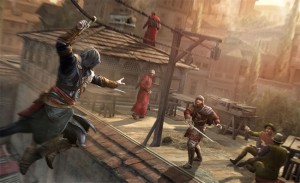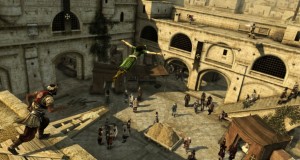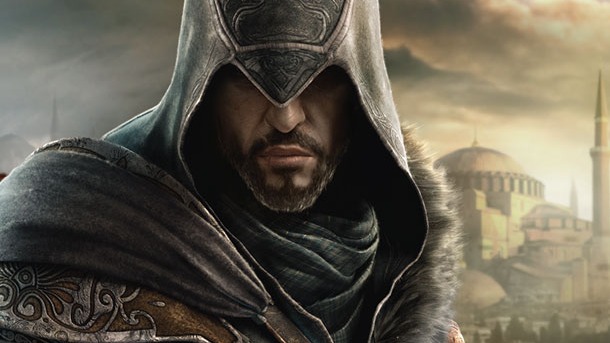 “You know what was great? Assassins Creed 2! You know what was even better? Assassins Creed: Brotherhood. Man, I sure could go for more Assassins Creed right now!”
“You know what was great? Assassins Creed 2! You know what was even better? Assassins Creed: Brotherhood. Man, I sure could go for more Assassins Creed right now!”
If this is you, you’re in for a treat.
“I like the Assassins Creed games, but I can’t wait to see what major new advances they put in to Revelations. I hope the changes are as big was when you went from Altair to Ezio.”
If that’s you, you may come away from Revelations a little underwhelmed.
The latest entry in the series picks up directly from the puzzling denouement of Brotherhood, where present day Desmond has committed acts outwith his own control and murdered one of his team of Inception-style dream technicians. Quickly falling into a coma-like state, Desmond’s fractured psyche is held together by the virtual world of the Animus; his torpor in the real world reflected in his existence in the limbo-like base program of the machine. Its an inviting opening and quickly sets up the rather simplistic main plot line of the game; replay memories of Ezio (and through him Altair) to help Desmond piece his own mind back together and wake up. You hear some echoes of the real world through distant dialogue, but its the mysterious man trapped in the limbo-world with you who is your main guide throughout the game. You escape each time not to the real world but back to the Animus’ safe mode, known as the Black Room. The strangers identity isn’t hard to guess for those who have played the previous games, but he’s a suitably engaging figure with which to start the campaign.
 Revelations wastes little time with exposition. If you haven’t played the previous games it might be a good idea to brush up on the main story points before you set off. Gameplay wise its similarly unwilling to push you through too many tutorial missions. There are a great deal of options for escaping the main story and entering training modes to learn the basics, but you can’t help but feel that the casual gamer will be completely overwhelmed with the number of moves, techniques and weapons that are at Ezio’s disposal. Initially you are taught how to use new items like the hookblade and a variety of types of bombs, but the focus is on teaching you the new additions rather than taking you through every possible item and technique available to the player. It’s amazing how many more options are available to the player in this new game than back in the first title, and in truth the controller sometimes struggles to fit all of those options onto the buttons available. Running with the right trigger hold down for high profile actions, the A buttons held for running and then pressing the B button to swing further on a hanging lamp is hard to process while you are being chased by angry guards, and to a newcomer it must seem positively unwelcoming to have to learn so many button combinations. Its amausing to think that when the first Assassins Creed was released it was considered to be too “casual” as it automated the free running and the combat was deemed simplistic, whereas now you would struggle to find another game with more complexity in the actions it allows.
Revelations wastes little time with exposition. If you haven’t played the previous games it might be a good idea to brush up on the main story points before you set off. Gameplay wise its similarly unwilling to push you through too many tutorial missions. There are a great deal of options for escaping the main story and entering training modes to learn the basics, but you can’t help but feel that the casual gamer will be completely overwhelmed with the number of moves, techniques and weapons that are at Ezio’s disposal. Initially you are taught how to use new items like the hookblade and a variety of types of bombs, but the focus is on teaching you the new additions rather than taking you through every possible item and technique available to the player. It’s amazing how many more options are available to the player in this new game than back in the first title, and in truth the controller sometimes struggles to fit all of those options onto the buttons available. Running with the right trigger hold down for high profile actions, the A buttons held for running and then pressing the B button to swing further on a hanging lamp is hard to process while you are being chased by angry guards, and to a newcomer it must seem positively unwelcoming to have to learn so many button combinations. Its amausing to think that when the first Assassins Creed was released it was considered to be too “casual” as it automated the free running and the combat was deemed simplistic, whereas now you would struggle to find another game with more complexity in the actions it allows.
That being said the additions to Ezio’s move list are all welcome. Although its showcased as one of the main additions to both his arsenal and how he moves through the game world, the hookblade is very simple to use. Ezio climbs faster and can jump to reach higher locations with it, and it makes his climbing animations even better looking. He can also use it to cling to ledges when he tries very long jumps which he doesn’t quite make, and its useful in combat too where it adds a few key, ninja-style moves.
 Other than the addition of more animations and weapons, the majority of the combat and the traversal are the same. Assassins Creed is a series which has been fine-tuned over a series of iterations and you feel the confidence of the developers throughout this new game, if not always the ambition.
Other than the addition of more animations and weapons, the majority of the combat and the traversal are the same. Assassins Creed is a series which has been fine-tuned over a series of iterations and you feel the confidence of the developers throughout this new game, if not always the ambition.
The first few hours of the game are a little patchy and it takes a while to hit its stride. Starting in Masyaf, Ezio encounters some serious opposition from his target and his assassination mission, although eventually successful, results in the somewhat predictable loss of a lot of his tools of the trade. Despite that fact that he loses many of his key weapons – like his double-hidden blades – he still has a good arsenal of weapons to choose from, even at the start of the game. This arsenal only grows, most especially once he starts constructing bombs. The crafting of explosives is one of the biggest new features and although I found the idea unappealing at first, its so well implemented and well thought out that I wasted hours on this one part alone. Each bomb is made of three parts: casing, gunpowder and the ingredient to give the desired effect. You can carry three types of bombs, tactical, diversionary and offensive. There are supposedly three hundred different recipes, and although I imagine many of them are very similar I am still finding new uses for them now. For example, using a mine shell casing, I made a shrapnel bomb to kill an assassination target. A totally different type used British gunpowder and a sticky shellcasing with smoke, which allowed me to place it on a column near my intended victim. When my target tripped it, I wondered into the midst of the choking, blinded guards with my eagle vision active and knifed him before casually walking to safety. The key thing here is how the bombs are used. Ubisoft makes them a toy to play with rather than prescribes their use. Quite simply they give you one more way for Ezio to pull off incredibly impressive kills.
 The bombs aren’t the only new gameplay system piled onto the frame of the game. There’s also a tower defence-style mingame that involves commanding your assassins to defend a den from Templar attacks. Building barricades, placing archers and gunmen and calling down cannon artillery, its a curious addition that doesn’t quite work. Using the normal game engine, you move a cursor with one stick and Ezio’s viewpoint with the other and like everything else in the game it takes some practice to control efficiently. Although I called it a minigame its deep and complex – so much so that it might represent Ubisoft using its inclusion as a pilot test. A possible tower defense/RTS Assassins Creed spin off? It might work; although I didn’t enjoy it much your mileage may vary.
The bombs aren’t the only new gameplay system piled onto the frame of the game. There’s also a tower defence-style mingame that involves commanding your assassins to defend a den from Templar attacks. Building barricades, placing archers and gunmen and calling down cannon artillery, its a curious addition that doesn’t quite work. Using the normal game engine, you move a cursor with one stick and Ezio’s viewpoint with the other and like everything else in the game it takes some practice to control efficiently. Although I called it a minigame its deep and complex – so much so that it might represent Ubisoft using its inclusion as a pilot test. A possible tower defense/RTS Assassins Creed spin off? It might work; although I didn’t enjoy it much your mileage may vary.
Throughout the campaign there’s a sense that Ubisoft has worked hard to refine the gameplay formula. There are as many subtractions as additions. While you still sync viewpoints to expand the map, buy and upgrade equipment and assassinate captains to unlock hideouts and shops which you then renovate, there’s no Anmius puzzle sections any more. Reducing your profile when the guards are after you can no longer be done by ripping down posters, and the long dungeon sequences now have as much emphasis on stealth kills as platforming ability. The games also clearer about the optional extra goals it sets you for each mission to achieve a 100% sync rating. These mini-achievements encourage you to try to tackle objectives in certain ways, for example kill a target using poison or complete a mission with no civilian casualties. These are almost always fun to try and with a few extremely frustrating exceptions, they offer a compelling challenge and are often puzzles in their own right.
 The most pleasing feature to return though is the assassin sideckicks you recruit. With more effort put into the characterisation of these characters and the missions you undertake to recruit them, they feel more akin to the Mass Effect team than the blank templates they were in Brotherhood. Everything about levelling, customising and sending them out on missions has been polished and improved, and holding your hand up to call them in remains one of the coolest things you can do in any modern videogame. I was particularly pleased in one mission, because when I called in an assassin to kill a main storyline target, the cut scene that followed had my trusted assistant hear the villains dying words rather than Ezio. Its nice to see how much thought has been put into this, and after Brotherhood I was worried that this might have been one part of the Assassins Creed experience the developers would remove. Casual observers might think it would make the game too easy, but like most other features in the game it simply gives the player more options rather than removing the challenge.
The most pleasing feature to return though is the assassin sideckicks you recruit. With more effort put into the characterisation of these characters and the missions you undertake to recruit them, they feel more akin to the Mass Effect team than the blank templates they were in Brotherhood. Everything about levelling, customising and sending them out on missions has been polished and improved, and holding your hand up to call them in remains one of the coolest things you can do in any modern videogame. I was particularly pleased in one mission, because when I called in an assassin to kill a main storyline target, the cut scene that followed had my trusted assistant hear the villains dying words rather than Ezio. Its nice to see how much thought has been put into this, and after Brotherhood I was worried that this might have been one part of the Assassins Creed experience the developers would remove. Casual observers might think it would make the game too easy, but like most other features in the game it simply gives the player more options rather than removing the challenge.
Ezio is a brilliant leading man and his incarnation in this game as an older, bearded protagonist is well judged. The culture clash between his Italian roots and the varied cast of Constantinople (now its Istanbul, now Const…..) feels real and makes for some amusing moments. He retains his charm with the ladies, so much so that one Ottoman NPC jokingly refers to him as Lothario (“What? All those Italian names sound the same”). It shouldn’t come as too much of a spoiler that you also play as Altair, and his inclusion is pleasing more for the variety that it adds to the story than the inclusion of his somewhat stoic character. The gameplay differences he adds and the difference of tone in his portions of the game break the story up well.
 The multiplayer part of the package has been polished and updated too, and it feels like a full experience rather than a thought experiment now. I had immense fun with this, but I found it hard to pin down exactly why it was so much better than in Brotherhood. The levelling of your character, unlocking of perks and characters and sheer depth of this mode could see it becoming a real contender rather than something that is only played for the first month after the games release. There’s nothing else like it, and the fact that Ubisoft have concocted such a brilliantly tense and thrilling type of multiplayer game that is so unique is an achievement not to be understated. Fundamentally almost all multiplayer games involving shooting each other in one way or another, so creating a multiplayer game that is about sneaking and hiding in crowds is both brave and praise-worthy.
The multiplayer part of the package has been polished and updated too, and it feels like a full experience rather than a thought experiment now. I had immense fun with this, but I found it hard to pin down exactly why it was so much better than in Brotherhood. The levelling of your character, unlocking of perks and characters and sheer depth of this mode could see it becoming a real contender rather than something that is only played for the first month after the games release. There’s nothing else like it, and the fact that Ubisoft have concocted such a brilliantly tense and thrilling type of multiplayer game that is so unique is an achievement not to be understated. Fundamentally almost all multiplayer games involving shooting each other in one way or another, so creating a multiplayer game that is about sneaking and hiding in crowds is both brave and praise-worthy.
All of these features, modes and gameplay additions are built upon the foundation of a truly stunning world that is a joy to explore. Whether your renovating stores, stalking targets, killing guards on rooftops or just looking out over gorgeous vistas of a living, breathing city from the spire of a thousand foot tower, few games take you out of the real world and deposit you in another so completely. As you scour the city there are so many things to do, see, build, kill and climb that you will feel the need to eat, sleep or go to the bathroom fade into insignificance. Constantinople is not always as gorgeous as Rome, but its not far off and as you explore it the sound effect and music score are some of the best and most immersive in any open world game. The moments when you leave Constantinople offer good variety and feature all sorts of different environments to explore, including the world of the Animus and Desmond’s splintered mind.
 Revelations treads a fine line between refinement and stagnancy. It takes many of the experimental ideas from the previous games and improves upon them, stripping away the things that didn’t work and focusing on those that did. Meanwhile, it doesn’t add as much as any of the previous games, so its easy to see how it could be criticized as being “more of the same”. As the final part of the Ezio Auditore trilogy though, its satisfying and acts as a perfect bookmark to the adventures of the Italian maestro while acting as a stepping off point to the next instalment in the series. That next instalment though will need to take big changes to the formula if it is to avoid criticism for lack of innovation. With Revelations, Ubisoft have worn out Ezio’s welcome and when we leave his company we are glad to do so. When (or if) Demsond jumps into another body, it will have to be in a far different environment and as a totally original character. Failing that, an opporuntiy to play as Desmond himself in a modern day setting has never been a more exciting prospect.
Revelations treads a fine line between refinement and stagnancy. It takes many of the experimental ideas from the previous games and improves upon them, stripping away the things that didn’t work and focusing on those that did. Meanwhile, it doesn’t add as much as any of the previous games, so its easy to see how it could be criticized as being “more of the same”. As the final part of the Ezio Auditore trilogy though, its satisfying and acts as a perfect bookmark to the adventures of the Italian maestro while acting as a stepping off point to the next instalment in the series. That next instalment though will need to take big changes to the formula if it is to avoid criticism for lack of innovation. With Revelations, Ubisoft have worn out Ezio’s welcome and when we leave his company we are glad to do so. When (or if) Demsond jumps into another body, it will have to be in a far different environment and as a totally original character. Failing that, an opporuntiy to play as Desmond himself in a modern day setting has never been a more exciting prospect.
As it stands, Revelations represents the best mission design, gameplay balance and storyline progression in any of the games so far. There are times throughout the campaign where you want a friend around just to come and witness the story twists and turns, the funny little moments of character dialogue or the newest insanely cool assassination you have managed to engineer with your repertoire of deadly skills and abilities. If you are thoroughly satiated on the basic Assassins Creed formula, feel free to knock a couple of points off the score. However, if you think to yourself “Man, I sure could go for more Assassins Creed right now!”, then you are in for a treat. This is more Assassins Creed. Ezio may now be old, but he still has what it takes for this one last contract.
9 suspicious hay carts out of 10
